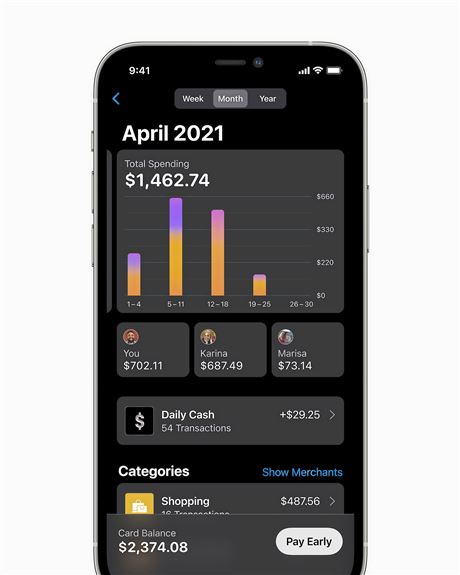Sharing a credit card account with family members and close friends will give them access to credit they wouldn’t have had, but it also can be a recipe for trouble, especially if their spending habits were to get out of control.
A new credit card being introduced by Apple this month allows up to five people — family and non-family members — to build their credit histories together. It’s designed to help ease some of the risk that comes with linking others to a single credit card account.
Apple Card Family is similar to other credit cards on the market that allow the primary account owner to add authorized users. But this one gives parents the ability to set spending limits on children and even track all their purchases in real time.
“We designed Apple Card Family because we saw an opportunity to reinvent how spouses, partners and people you trust share credit cards and build credit together,” said a news release issued by the company.
Usually, when two or more people use the same credit card, the primary account holder receives the benefit of building a credit history, while anyone else using the card does not.
“Apple Card Family lets people build their credit history together,” the company said.
While credit card companies often encourage account owners to add authorized users to the account, some financial advisers don’t recommend it.
“I have a hard time understanding why someone age 18 needs a good credit score. They need a job first, and they need to learn to pay their own expenses with cash,” said Chris Chaney, a vice president at Fort Pitt Capital Group in Green Tree.
“When the time comes to make a major purchase like a car or a house, then mom and dad can help,” Mr. Chaney added. “My attitude is you need to treat credit with fear and loathing.”
He doesn’t recommend giving teenagers a credit card, but he thinks the Apple Card Family is a mixed bag because it’s set up so parents can use it as a training tool.
“You’re right there and can provide real-time guidance and help them build good habits,” he said. “I would much rather have an 18-year-old under the family umbrella than have their own unsupervised credit card.”
Using limits
Adding a family member or friend to an existing credit card account is a common method of helping someone with poor credit or no credit history gain access to credit, even if it doesn’t help improve the user’s credit score.
A practice known as “piggybacking” used to be popular about a decade ago because authorized users were able to build their credit by being added to another person’s account.
But fraud in that system became so rampant that many companies, starting in 2008, stopped reporting authorized users’ information to credit bureaus in a way that helped them build credit. In some cases, authorized users’ activity is only reported on the main cardholder’s credit report, which defeats the point of piggybacking.
People as young as 13 can be added as an authorized user on the Apple Card Family, but the card won’t help them build credit until they reach age 18.
All account activity, including positive and negative payment history, will be reported to the credit bureaus for the card owners and all the card participants who opt in to credit reporting. But the card owner is solely responsible for paying the bill.
Bill Hardekopf, a senior credit analyst at CardRates.com, based in Gainesville, Fla., said credit card companies frequently allow cardholders to add their children and friends as authorized users. The big difference with Apple Card Family is card owners can put limits on how much authorized users can spend.
“You can limit your daughter to a $100 spending limit,” Mr. Hardekopf said. “With any of the other cards on the market — Chase, Citi or American Express — you can’t put in a specific amount to spend.
“You can monitor the spending, too,” he said. “You can see how much and where they are spending in real time. You also get alerts when a transaction is made. That’s a pretty neat feature.”
Some debit cards also have that feature. One of them is the GreenLight Kids’ Debit Card. It allows parents to send money to their children from a smartphone and get real-time notifications every time their kid spends money.
Apple Card Family doesn’t charge fees — no annual or late fees, no foreign transaction fees or over-the-limit fees. It’s not the only credit card on the market waiving those fees, but it’s another favorable aspect of the card.
“What Apple is obviously trying to do is get more people to be iPhone users and to use the Apple Wallet app,” Mr. Hardekopf said. “You have to have an iPhone, the last iOS update and have an Apple Wallet app, and they encourage you to make the transactions with Apple Pay.
“Apple is obviously trying to increase usage of their products,” he said. “That’s their whole endgame, and they are providing an attractive credit card for that.”
Evaluating the risks
Financial adviser Adam Yofan at Buckingham Strategic Wealth, Downtown, said he’s not a fan of parents linking their children to a credit card. None of his clients do it for their children, he said.
“If I’m on a credit card with my son or daughter, they can put my finances and my credit score at risk with whatever they do, and I don’t want that risk,” he said. “They are on social media, and they are targeted by scammers who steal identities.”
He prefers other methods of helping children build credit and learn to manage money that don’t involve giving them a credit card the parent is associated with.
Some other ideas, he said, include getting them a pre-paid credit card or going to the bank with them and co-signing for a small loan they can pay back.
“Those ideas all have limited risk to the parents’ finances and potential for identity theft,” Mr. Yofan said. “Having a joint credit card with a kid is not even something I would advise.”
Tim Grant: tgrant@post-gazette.com or 412-263-1591
First Published: May 4, 2021, 9:59 a.m.





















